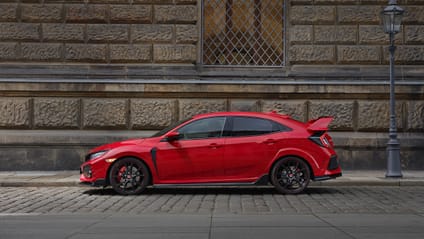
Honda Civic Type R: Top Gear magazine’s Car of the Year 2017
To win one award is considered good. To win three is plain greedy.

2076
Not only has the all-new Honda Civic Type R been crowned Hot Hatch of the Year, it was also voted International Editors’ Choice and overall Car of the Year. Quite an achievement, but then this fifth-generation Civic Type R is quite a car.
Advertisement - Page continues belowHow it all began

The first ever Honda ‘Type R’ arrived in 1992, but it wasn’t a Civic. It was the original NSX, the Japanese manufacturer’s first ever supercar, developed with the help of three-time Formula One World Champion Ayrton Senna. This was the car that would set the tone for a new performance brand that would come to rival anything in automotive history.
1997 (Japan only)

The Civic Type R story began 20 years ago, with the sixth generation of Honda’s popular hatchback. This original model was only available in Japan and the tell-tale Type R signs were there for all to see. The red Honda badge and the lowered stance; on the inside, the red seats, titanium gear knob and sports steering wheel. What really set the Type R apart though, was the engineering behind it. On this original model, a seam-welded monocoque chassis and series of weight-saving modifications really made the performance difference.
Advertisement - Page continues below2001

And here’s the car that kick-started Europe’s love affair with the Civic Type R (officially, anyway). This is the one every petrolhead remembers fondly; the one that won multiple awards, including Hot Hatch of the Year from Top Gear. It was pure Type R: a 197bhp, 2.0 litre VTEC engine, mated to a precise, close ratio six-speed gearbox, ready to reward any driver willing (or able) to use its full 8,000rpm power band. And that specially-welded, stiffened chassis was more than capable of hanging on long after the power had run out…
2007 (Japan only)

Honda developed two Type R variants of the next generation Civic. It was bigger, wider and heavier than its predecessor but the Japan-only, four-door version was also more powerful, boasting around 222hp. The styling proved to be a bit hit-or-miss with the Japanese public and only a modest 13,000 examples were produced before production ceased in 2010. It has become something of a cult classic in Japan where those low numbers and a love of modifying anything even vaguely quick has kept interest high.
2007

Unlike the Japan-only, four-door version, power in the European spec, two-door hatchback variant was unchanged from that of the previous era Civic Type R. Its extra mass and weight meant this model would not become famous for its outright performance. Though with its simpler torsion beam suspension set-up – as opposed to double wishbone – it was, by some margin, a more comfortable Type R on long-distance journeys. As with the four-door version, production ceased in 2010 as the normally-aspirated VTEC engine fell foul of impending Euro V emissions regulations.
2015

And that, for almost eight years, was that, until the legend was reborn in 2015. The fourth-generation Civic Type R was based around the ninth generation Civic, and powered by an all new, turbocharged VTEC engine. And what an engine: direct injection, a twin scroll turbo and four-cylinders, producing 306bhp and 400NM of torque. This fastest, most powerful Civic Type R yet may have grown into a five-door hatchback, but it was also quick enough to wrest the title of fastest front wheel drive car ever around the Nürburgring Nordschleife from rivals Renault and SEAT.
Advertisement - Page continues below2017

Just two years later, the Type R story gets a new chapter. Power is up again (320PS) and the lap record for front-wheel drive cars around the Nordschleife has been lowered further still. This all-new car shaves a full seven seconds from its own previous benchmark, setting a new world record lap time of 7:43:80. The 2017 version provides the driver with a choice of three distinct modes: Comfort, for unrivalled usability (softer suspension; lighter steering feel); Sport, the default setting combining comfort with a more dynamic driving experience; and +R, for a more aggressive overall performance set-up, including enhanced engine response and adjusted torque-mapping.
Featured

Trending this week
- Car Review
BMW iX3




